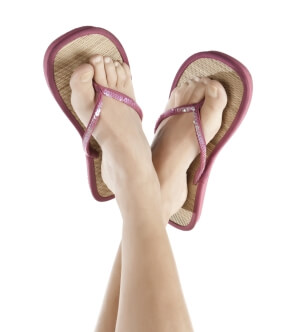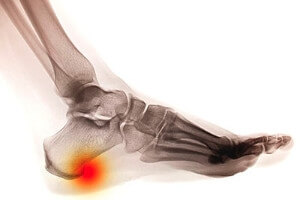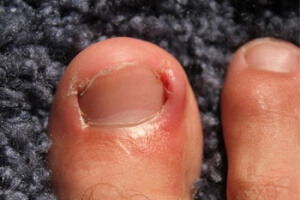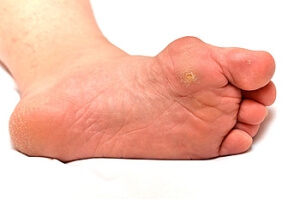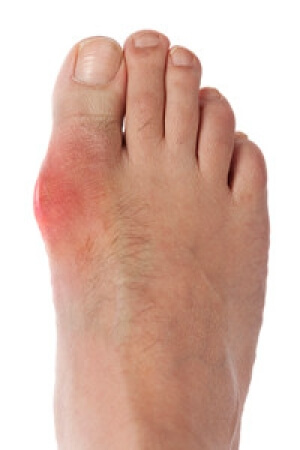Super User
Are Flip Flops Good for my Feet?
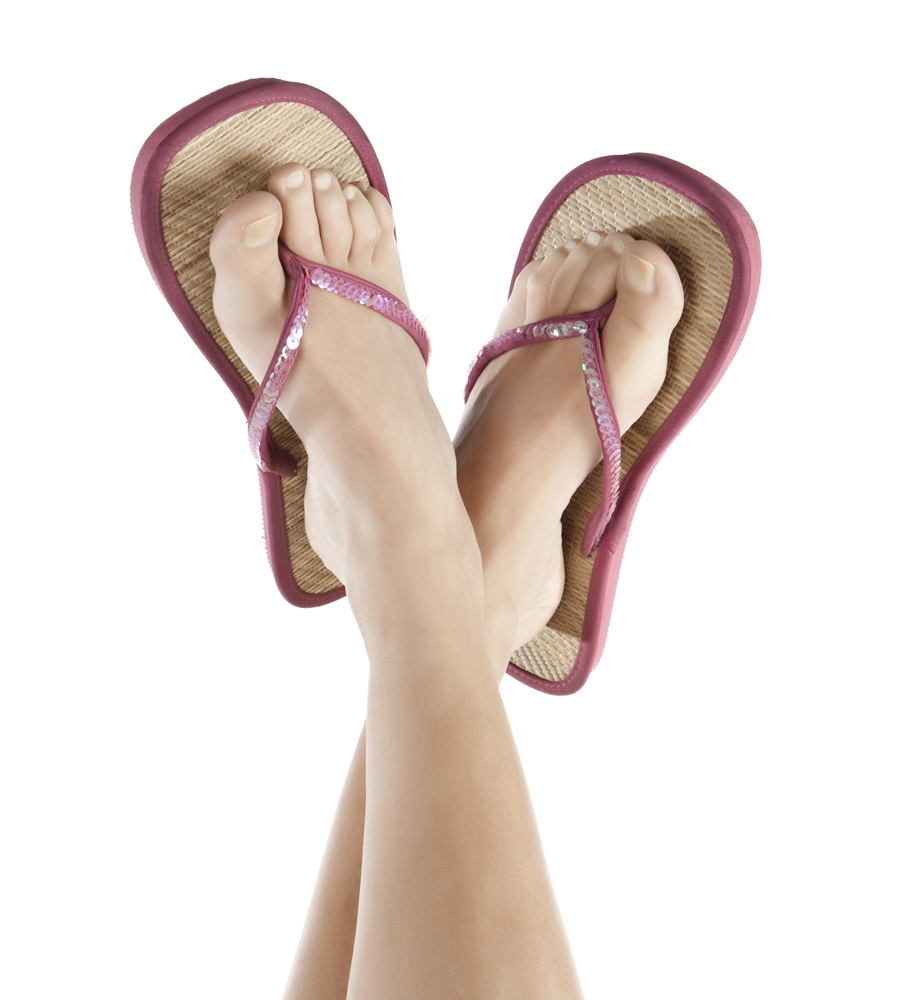 The idea of wearing flip flops can be enticing in the hot summer months. They can easily be worn for most daily activities and many are available in attractive colors. Despite their popularity, if you choose to wear flip flops you may be inviting the formation of painful foot conditions. The plantar fascia provides the necessary support the foot needs while connecting the toes to the heel bone. Wearing flip flops can cause this tissue to become inflamed, which may often result in discomfort and pain. Additionally, the Achilles tendon may be at risk for injury as a result of the lack of arch support that comes from wearing flip flops. If you are afflicted with diabetes, you may have nerve damage which can hinder the ability to feel any cuts that the material between the toes may incur. If you choose to wear this type of shoe, it’s best to do so in moderation, and this may possibly avoid potential foot problems that may be associated with wearing flip flops.
The idea of wearing flip flops can be enticing in the hot summer months. They can easily be worn for most daily activities and many are available in attractive colors. Despite their popularity, if you choose to wear flip flops you may be inviting the formation of painful foot conditions. The plantar fascia provides the necessary support the foot needs while connecting the toes to the heel bone. Wearing flip flops can cause this tissue to become inflamed, which may often result in discomfort and pain. Additionally, the Achilles tendon may be at risk for injury as a result of the lack of arch support that comes from wearing flip flops. If you are afflicted with diabetes, you may have nerve damage which can hinder the ability to feel any cuts that the material between the toes may incur. If you choose to wear this type of shoe, it’s best to do so in moderation, and this may possibly avoid potential foot problems that may be associated with wearing flip flops.
Flip-flops can cause a lot of problems for your feet. If you have any concerns about your feet or ankles, contact one of our podiatrists from New Tampa Foot & Ankle. Our doctors will assist you with all of your foot and ankle needs.
Flip-Flops and Feet
Flip-flops have managed to become a summer essential for a lot of people. While the shoes may be stylish and easy to slip on and off, they can be dangerous to those who wear them too often. These shoes might protect you from fungal infections such as athlete’s foot, but they can also give you foot pain and sprained ankles if you trip while wearing them.
When Are They Okay to Wear?
Flip-flops should only be worn for very short periods of time. They can help protect your feet in places that are crawling with fungi, such as gym locker rooms. Athlete’s foot and plantar warts are two common fungi that flip-flops may help protect your feet against.
Why Are They Bad for My Feet?
These shoes do not offer any arch support, so they are not ideal for everyday use. They also do not provide shock absorption or heel cushioning which can be problematic for your feet. Additionally, you may suffer from glass cuts, puncture wounds, and stubbed toes since they offer little protection for your feet.
More Reasons Why They Are Bad for Your Feet
- They Slow You Down
- May Cause Blisters and Calluses
- Expose Your Feet to Bacteria
If you have any questions, please feel free to contact our office located in Wesley Chapel, FL . We offer the newest diagnostic and treatment technologies for all your foot care needs.
Flip Flops and Feet
Flip flops are often a popular choice of footwear for many people. Flip flops allow your feet to breathe and give your toes the freedom of movement. They are easy to slip on and can be worn with virtually any style of clothing. Flip flops, however, despite their many benefits, can be detrimental for your foot health.
Despite their comfortableness, frequently wearing flip flops can create problems in the lower body over time. Issues mainly stem from the fact that people walk differently in flip flops compared to other footwear, such as sneakers. This is due to a change in one’s natural gait, which therefore creates stress in different parts of the body while hindering the body’s natural posture. Problems can also arise in the arches and balls of the feet. Flip flops provide little to no support to these areas.
Aside from long-term problems, flip-fops can also create short-term issues as well, such as ankle sprains and blisters. Weak materials that are flexible and bendable are generally used to manufacture flip flops. These materials make its wearers prone to both tripping and injuring their ankles. Flip flops can create blisters as the material rubs against the foot. People are much more at risk for infection while wearing flip flops due to their openness. This also makes it easier to scrape and cut the foot since there is a lack of protection. If these cuts are left untreated and uncovered, the risk then becomes greater.
To prevent the aforementioned occurrences, purchase a pair of flip flops that offer significant protection. The soles of the flip flops should not be floppy, but sturdy and firm, and should not significantly bend or wiggle when lifted from the floor. Flip flops made of high-quality materials will not be affected by this problem. While higher quality flip flops may be more expensive, they will last longer and provide better protection compared to a cheaper pair. Brand name flip flops sold from a quality manufacturer are a dependable option.
There is no problem in wearing your favorite pair of flip flops so as long as you do not wear them daily or for extended periods of time. Flip flops should be replaced every 3-4 months to ensure that they provide your feet with the best protection.
The Importance of Properly Stretching The Feet While Working
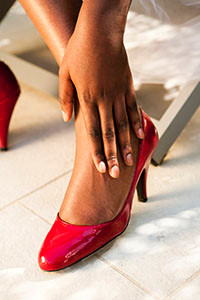 For people who stand or walk during work for the majority of the day, it may be common to experience pain, discomfort and muscle strain throughout the body. Research has shown the importance of wearing proper footwear that will provide the necessary support for optimum comfort. Flip flops, high heels, and sandals may not be the best choice for working on your feet all day. These types of shoes may alter the way you walk, in addition to possibly cramping the toes or shortening the stride. It may be beneficial to stretch the feet before and after work. This may aid in developing the necessary muscle strength to help the feet to feel more comfortable during the day. Effective exercises that may accomplish this, are pointing and flexing the feet, in addition to performing exercises that strengthen the hips, legs, and feet. Please consult with a podiatrist for suggestions and additional information on how to properly stretch your feet.
For people who stand or walk during work for the majority of the day, it may be common to experience pain, discomfort and muscle strain throughout the body. Research has shown the importance of wearing proper footwear that will provide the necessary support for optimum comfort. Flip flops, high heels, and sandals may not be the best choice for working on your feet all day. These types of shoes may alter the way you walk, in addition to possibly cramping the toes or shortening the stride. It may be beneficial to stretch the feet before and after work. This may aid in developing the necessary muscle strength to help the feet to feel more comfortable during the day. Effective exercises that may accomplish this, are pointing and flexing the feet, in addition to performing exercises that strengthen the hips, legs, and feet. Please consult with a podiatrist for suggestions and additional information on how to properly stretch your feet.
While working on the feet, it is important to take the proper care of them. For more information about working on your feet, contact one of our podiatrists from New Tampa Foot & Ankle. Our doctors will treat your foot and ankle needs.
Working on Your Feet
Standing on your feet for long periods of time can cause stress and pain in your feet. Your whole body may experience change in terms of posture, back pain, bunions, callouses and or plantar warts. There are ways to avoid these conditions with proper foot care, smart choices and correct posture.
Positive Changes
Negative heeled shoe – Choosing this shoe type places the heel slightly lower than the ball of the foot. These are great for overall foot health. Find shoes that fit you correctly.
Go barefoot – Our feet were not designed to be enclosed for all hours of the day. Try to periodically expose your feet to air.
Eliminate Pain
Foot Exercises – Performing simple exercises, incorporating yoga and doing stretches are beneficial. This will allow increased blood flow to the area and muscles of the foot.
Achilles tendon – Stretching the foot out flat on the floor will relax the calf muscles and tendon. These exercises can be performed almost anywhere. Make sure you add these exercises to your daily regimen.
With a little bit of this information and knowing more about foot health, you will notice changes. Foot stretches and proper footwear will help with pain and prevent further issues.
If you have any questions please feel free to contact our office located in Wesley Chapel, FL . We offer the newest diagnostic and treatment technologies for all your foot and ankle needs.
How to Alleviate Swollen Feet During Pregnancy
 It’s common for most women to experience swollen feet during their pregnancy. It’s considered normal for both feet to be affected, but your doctor should be contacted promptly if only one foot is swollen. There are several effective ways that may aid in reducing a portion of the swelling. These may include elevating your feet and legs frequently during the day, preferably above heart level. Additionally, performing foot and ankle stretches may help to pump excess fluid from the feet and legs. Many women have found that wearing compression stockings may help swollen feet from becoming worse during the day. Research has shown that limiting salt intake and drinking plenty of fresh water frequently may aid in the reduction of excess fluid, which often contributes to swollen feet during pregnancy.
It’s common for most women to experience swollen feet during their pregnancy. It’s considered normal for both feet to be affected, but your doctor should be contacted promptly if only one foot is swollen. There are several effective ways that may aid in reducing a portion of the swelling. These may include elevating your feet and legs frequently during the day, preferably above heart level. Additionally, performing foot and ankle stretches may help to pump excess fluid from the feet and legs. Many women have found that wearing compression stockings may help swollen feet from becoming worse during the day. Research has shown that limiting salt intake and drinking plenty of fresh water frequently may aid in the reduction of excess fluid, which often contributes to swollen feet during pregnancy.
Pregnant women with swollen feet can be treated with a variety of different methods that are readily available. For more information about other cures for swollen feet during pregnancy, consult with one of our podiatrists from New Tampa Foot & Ankle. Our doctors will attend to all of your foot and ankle needs.
What Foot Problems Can Arise During Pregnancy?
One problem that can occur is overpronation, which occurs when the arch of the foot flattens and tends to roll inward. This can cause pain and discomfort in your heels while you’re walking or even just standing up, trying to support your baby.
Another problem is edema, or swelling in the extremities. This often affects the feet during pregnancy but tends to occur in the later stages.
How Can I Keep My Feet Healthy During Pregnancy?
- Wearing orthotics can provide extra support for the feet and help distribute weight evenly
- Minimize the amount of time spent walking barefoot
- Wear shoes with good arch support
- Wear shoes that allow for good circulation to the feet
- Elevate feet if you experience swelling
- Massage your feet
- Get regular, light exercise, such as walking, to promote blood circulation to the feet
If you have any questions please feel free to contact our office located in Wesley Chapel, FL . We offer the newest diagnostic and treatment technologies for all your foot and ankle needs.
What is a Heel Spur?
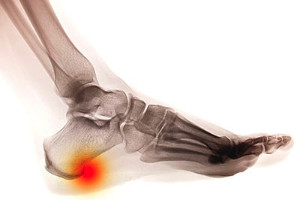 The definition of a heel spur is a bony protrusion that comes from the heel of the foot and grows into the arch. This condition is often the result of tears in the plantar fasciitis which is a thick band of tissue that runs along the sole of the foot. General symptoms may include pain and discomfort under the heel which may be worse in the morning and experiencing a tender feeling when the heel is touched. There may be several causes for heel spurs to develop, including excess weight the heel endures from being obese, certain sporting activities that puts pressure on the heels, and wearing shoes that do not fit correctly. Research has shown that reducing the activities that may cause this condition may aid in the treatment of heel spurs. Please consult with a podiatrist for treatment options which may include being fitted for custom made orthotics and night splints.
The definition of a heel spur is a bony protrusion that comes from the heel of the foot and grows into the arch. This condition is often the result of tears in the plantar fasciitis which is a thick band of tissue that runs along the sole of the foot. General symptoms may include pain and discomfort under the heel which may be worse in the morning and experiencing a tender feeling when the heel is touched. There may be several causes for heel spurs to develop, including excess weight the heel endures from being obese, certain sporting activities that puts pressure on the heels, and wearing shoes that do not fit correctly. Research has shown that reducing the activities that may cause this condition may aid in the treatment of heel spurs. Please consult with a podiatrist for treatment options which may include being fitted for custom made orthotics and night splints.
Heel spurs can be incredibly painful and sometimes may make you unable to participate in physical activities. To get medical care for your heel spurs, contact one of our podiatrists from New Tampa Foot & Ankle. Our doctors will do everything possible to treat your condition.
Heels Spurs
Heel spurs are formed by calcium deposits on the back of the foot where the heel is. This can also be caused by small fragments of bone breaking off one section of the foot, attaching onto the back of the foot. Heel spurs can also be bone growth on the back of the foot and may grow in the direction of the arch of the foot.
Older individuals usually suffer from heel spurs and pain sometimes intensifies with age. One of the main condition's spurs are related to is plantar fasciitis.
Pain
The pain associated with spurs is often because of weight placed on the feet. When someone is walking, their entire weight is concentrated on the feet. Bone spurs then have the tendency to affect other bones and tissues around the foot. As the pain continues, the feet will become tender and sensitive over time.
Treatments
There are many ways to treat heel spurs. If one is suffering from heel spurs in conjunction with pain, there are several methods for healing. Medication, surgery, and herbal care are some options.
If you have any questions feel free to contact our office located in Wesley Chapel, FL . We offer the latest in diagnostic and treatment technology to meet your needs.
Causes of Ingrown Toenails
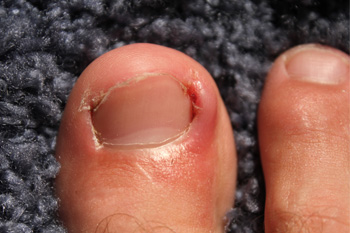 Onychocryptosis is another name for a condition known as ingrown toenails. It’s a painful ailment that is typically the result of the toenail growing into the skin. There are several causes for ingrown toenails including a genetic trait in which the toenails are too large for the nail bed, frequent running, or improper trimming of the nails. Additionally, an abnormal growth pattern may develop as a result of a fungal infection that may damage the root of the nail. This condition is easily identified by noticing any pain, tenderness, or swelling around the affected nail, and research has shown that proper treatment should begin as soon as possible. It may be beneficial to soak the foot in warm soapy water followed by applying a bandage to the affected toe. It’s suggested to consult with a podiatrist who can properly trim or remove the affected nail if a permanent solution is needed.
Onychocryptosis is another name for a condition known as ingrown toenails. It’s a painful ailment that is typically the result of the toenail growing into the skin. There are several causes for ingrown toenails including a genetic trait in which the toenails are too large for the nail bed, frequent running, or improper trimming of the nails. Additionally, an abnormal growth pattern may develop as a result of a fungal infection that may damage the root of the nail. This condition is easily identified by noticing any pain, tenderness, or swelling around the affected nail, and research has shown that proper treatment should begin as soon as possible. It may be beneficial to soak the foot in warm soapy water followed by applying a bandage to the affected toe. It’s suggested to consult with a podiatrist who can properly trim or remove the affected nail if a permanent solution is needed.
Ingrown toenails may initially present themselves as a minor discomfort, but they may progress into an infection in the skin without proper treatment. For more information about ingrown toenails, contact one of our podiatrists of New Tampa Foot & Ankle. Our doctors can provide the care you need to keep you pain-free and on your feet.
Ingrown Toenails
Ingrown toenails are caused when the corner or side of a toenail grows into the soft flesh surrounding it. They often result in redness, swelling, pain, and in some cases, infection. This condition typically affects the big toe and may recur if it is not treated properly.
Causes
- Improper toenail trimming
- Genetics
- Improper shoe fitting
- Injury from pedicures or nail picking
- Abnormal gait
- Poor hygiene
You are more likely to develop an ingrown toenail if you are obese, have diabetes, arthritis, or have any fungal infection in your nails. Additionally, people who have foot or toe deformities are at a higher risk of developing an ingrown toenail.
Symptoms
Some symptoms of ingrown toenails are redness, swelling, and pain. In rare cases, there may be a yellowish drainage coming from the nail.
Treatment
Ignoring an ingrown toenail can have serious complications. Infections of the nail border can progress to a deeper soft-tissue infection, which can then turn into a bone infection. You should always speak with your podiatrist if you suspect you have an ingrown toenail, especially if you have diabetes or poor circulation.
If you have any questions, please feel free to contact our office located in Wesley Chapel, FL . We offer the newest diagnostic and treatment technologies for all your foot care needs.
How Does a Bunion Form?
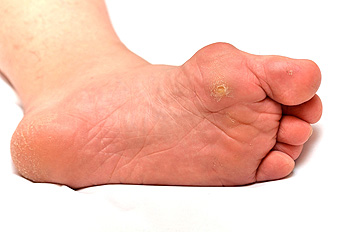 A bunion is considered to be a foot deformity that occurs on the side of the big toe. It will often begin slowly as the big toe gradually leans toward the toe next to it. A change in the structure of the foot may be a result of this, and this misalignment causes a bony protrusion to form on the side of the toe. A common cause of this condition may be because of a genetic trait that produces specific foot types, and research has shown this may be a contributing factor in the development of bunions. Choosing to wear poorly fitting shoes could make an already existing case of bunions even worse. There are several symptoms associated with the formation of bunions, which are often felt as a burning or numbing sensation. Additionally, the toe may become sore, red and tender. If you have developed a bunion, it’s suggested to consult with a podiatrist to learn about correct treatment options.
A bunion is considered to be a foot deformity that occurs on the side of the big toe. It will often begin slowly as the big toe gradually leans toward the toe next to it. A change in the structure of the foot may be a result of this, and this misalignment causes a bony protrusion to form on the side of the toe. A common cause of this condition may be because of a genetic trait that produces specific foot types, and research has shown this may be a contributing factor in the development of bunions. Choosing to wear poorly fitting shoes could make an already existing case of bunions even worse. There are several symptoms associated with the formation of bunions, which are often felt as a burning or numbing sensation. Additionally, the toe may become sore, red and tender. If you have developed a bunion, it’s suggested to consult with a podiatrist to learn about correct treatment options.
If you are suffering from bunion pain, contact one of our podiatrists of New Tampa Foot & Ankle. Our doctors can provide the care you need to keep you pain-free and on your feet.
What Is a Bunion?
Bunions are painful bony bumps that usually develop on the inside of the foot at the joint of the big toe. As the deformity increases over time, it may become painful to walk and wear shoes. Women are more likely to exacerbate existing bunions since they often wear tight, narrow shoes that shift their toes together. Bunion pain can be relieved by wearing wider shoes with enough room for the toes.
Causes
- Genetics – some people inherit feet that are more prone to bunion development
- Inflammatory Conditions - rheumatoid arthritis and polio may cause bunion development
Symptoms
- Redness and inflammation
- Pain and tenderness
- Callus or corns on the bump
- Restricted motion in the big toe
In order to diagnose your bunion, your podiatrist may ask about your medical history, symptoms, and general health. Your doctor might also order an x-ray to take a closer look at your feet. Nonsurgical treatment options include orthotics, padding, icing, changes in footwear, and medication. If nonsurgical treatments don’t alleviate your bunion pain, surgery may be necessary.
If you have any questions, please feel free to contact our office located in Wesley Chapel, FL . We offer the newest diagnostic and treatment technologies for all your foot care needs.
What Causes Gout?
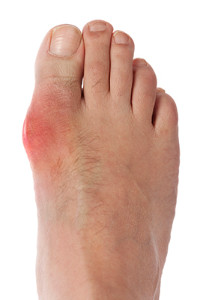 Common symptoms of gout may include severe pain, tenderness, and redness in the big toe and surrounding areas. It is considered to be a type of arthritis, and typically affects middle-aged men. It originates from a buildup of uric acid in the body, and may derive from certain foods including liver and seafood. The onset of gout occurs when the body has difficulty processing uric acid, and research has shown that it lodges in specific joints. The most common area for this to occur is in the big toe, and it often produces extreme pain and discomfort. There may be several reasons for gout to develop, including ingesting excess alcohol, being overweight, or from having a strong family history. It may be necessary for a proper diagnosis to be performed, which may include extracting a sample of the fluid that builds up between the joints. Acquiring knowledge about the prevention of gout may be beneficial in avoiding attacks in the future, and this may include choosing foods with lower uric acid levels.
Common symptoms of gout may include severe pain, tenderness, and redness in the big toe and surrounding areas. It is considered to be a type of arthritis, and typically affects middle-aged men. It originates from a buildup of uric acid in the body, and may derive from certain foods including liver and seafood. The onset of gout occurs when the body has difficulty processing uric acid, and research has shown that it lodges in specific joints. The most common area for this to occur is in the big toe, and it often produces extreme pain and discomfort. There may be several reasons for gout to develop, including ingesting excess alcohol, being overweight, or from having a strong family history. It may be necessary for a proper diagnosis to be performed, which may include extracting a sample of the fluid that builds up between the joints. Acquiring knowledge about the prevention of gout may be beneficial in avoiding attacks in the future, and this may include choosing foods with lower uric acid levels.
Gout is a painful condition that can be treated. If you are seeking treatment, contact one of our podiatrists from New Tampa Foot & Ankle. Our doctors will treat your foot and ankle needs.
What Is Gout?
Gout is a form of arthritis that is characterized by sudden, severe attacks of pain, redness, and tenderness in the joints. The condition usually affects the joint at the base of the big toe. A gout attack can occur at any random time, such as the middle of the night while you are asleep.
Symptoms
- Intense Joint Pain - Usually around the large joint of your big toe, and it most severe within the first four to twelve hours
- Lingering Discomfort - Joint discomfort may last from a few days to a few weeks
- Inflammation and Redness -Affected joints may become swollen, tender, warm and red
- Limited Range of Motion - May experience a decrease in joint mobility
Risk Factors
- Genetics - If family members have gout, you’re more likely to have it
- Medications - Diuretic medications can raise uric acid levels
- Gender/Age - Gout is more common in men until the age of 60. It is believed that estrogen protects women until that point
- Diet - Eating red meat and shellfish increases your risk
- Alcohol - Having more than two alcoholic drinks per day increases your risk
- Obesity - Obese people are at a higher risk for gout
Prior to visiting your podiatrist to receive treatment for gout, there are a few things you should do beforehand. If you have gout you should write down your symptoms--including when they started and how often you experience them, important medical information you may have, and any questions you may have. Writing down these three things will help your podiatrist in assessing your specific situation so that he or she may provide the best route of treatment for you.
If you have any questions, please feel free to contact our office located in Wesley Chapel, FL . We offer the newest diagnostic and treatment technologies for all your foot care needs.
Tips to Fight Against Foot Pain
 A recent survey has concluded that 8 out of 10 Americans have experienced some sort of foot problem. Depending on the specific condition, foot pain can cause problems throughout the day and may make completing everyday activities difficult. In order to prevent problematic foot conditions, you should make sure you are choosing the right shoes for your feet. When you are shopping for a new pair of shoes, you should ensure that there is at least half an inch of space between your longest toe and the top of the shoe. If you have foot pain, you shouldn't follow the adage, “If you can walk on it, it isn’t broken” because it isn’t true. If you are experiencing pain in your feet, you shouldn't hesitate to seek help from a podiatrist.
A recent survey has concluded that 8 out of 10 Americans have experienced some sort of foot problem. Depending on the specific condition, foot pain can cause problems throughout the day and may make completing everyday activities difficult. In order to prevent problematic foot conditions, you should make sure you are choosing the right shoes for your feet. When you are shopping for a new pair of shoes, you should ensure that there is at least half an inch of space between your longest toe and the top of the shoe. If you have foot pain, you shouldn't follow the adage, “If you can walk on it, it isn’t broken” because it isn’t true. If you are experiencing pain in your feet, you shouldn't hesitate to seek help from a podiatrist.
Everyday foot care is very important to prevent infection and other foot ailments. If you need your feet checked, contact one of our podiatrists from New Tampa Foot & Ankle. Our doctors can provide the care you need to keep you pain-free and on your feet.
Everyday Foot Care
Often, people take care of their bodies, face and hair more so than they do for their feet. But the feet are a very important aspect of our bodies, and one that we should pay more attention to. Without our feet, we would not be able to perform most daily tasks.
It is best to check your feet regularly to make sure there are no new bruises or cuts that you may not have noticed before. For dry feet, moisturizer can easily be a remedy and can be applied as often as necessary to the affected areas. Wearing shoes that fit well can also help you maintain good foot health, as well as making it easier to walk and do daily activities without the stress or pain of ill-fitting shoes, high heels, or even flip flops. Wearing clean socks with closed shoes is important to ensure that sweat and bacteria do not accumulate within the shoe. Clean socks help to prevent Athlete’s foot, fungi problems, bad odors, and can absorb sweat.
If you have any questions please feel free to contact our office located in Wesley Chapel, FL . We offer the newest diagnostic and treatment technologies for all your foot and ankle needs.
Surgery for Bunions
 If you experience a bony growth on the side of the big toe, you may have what is referred to as a bunion. This condition may require surgery to be performed, which will generally provide permanent relief. This surgical procedure typically involves removal of the bony protrusion or possibly a restructuring of the toes, which will depend on the severity of the bunion. Surgery will involve undergoing general or local anesthesia, which is determined based on each individual. There may be several ways to perform this type of operation, and it can typically depend on other factors involving the foot, such as any arthritis that may be present. Recovery includes utilizing a bandage or splint so the foot is protected and can rest comfortably. Crutches may be beneficial to use, which can aid in keeping weight off the toe. If you have a bunion and would like additional information about how surgery can be effective for you, please schedule a consultation with a podiatrist.
If you experience a bony growth on the side of the big toe, you may have what is referred to as a bunion. This condition may require surgery to be performed, which will generally provide permanent relief. This surgical procedure typically involves removal of the bony protrusion or possibly a restructuring of the toes, which will depend on the severity of the bunion. Surgery will involve undergoing general or local anesthesia, which is determined based on each individual. There may be several ways to perform this type of operation, and it can typically depend on other factors involving the foot, such as any arthritis that may be present. Recovery includes utilizing a bandage or splint so the foot is protected and can rest comfortably. Crutches may be beneficial to use, which can aid in keeping weight off the toe. If you have a bunion and would like additional information about how surgery can be effective for you, please schedule a consultation with a podiatrist.
Foot surgery is sometimes necessary to treat a foot ailment. To learn more, contact one of our podiatrists of New Tampa Foot & Ankle. Our doctors will assist you with all of your foot and ankle needs.
When Is Surgery Necessary?
Foot and ankle surgery is generally reserved for cases in which less invasive, conservative procedures have failed to alleviate the problem. Some of the cases in which surgery may be necessary include:
- Removing foot deformities like bunions and bone spurs
- Severe arthritis that has caused bone issues
- Cosmetic reconstruction
What Types of Surgery Are There?
The type of surgery you receive will depend on the nature of the problem you have. Some of the possible surgeries include:
- Bunionectomy for painful bunions
- Surgical fusion for realignment of bones
- Neuropathy decompression surgery to treat nerve damage
Benefits of Surgery
Although surgery is usually a last resort, it can provide more complete pain relief compared to non-surgical methods and may allow you to finally resume full activity.
Surgical techniques have also become increasingly sophisticated. Techniques like endoscopic surgery allow for smaller incisions and faster recovery times.
If you have any questions please feel free to contact our office located in Wesley Chapel, FL . We offer the newest diagnostic and treatment technologies for all your foot and ankle needs.
